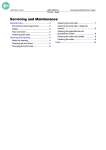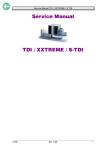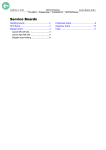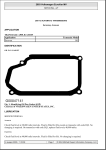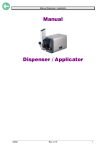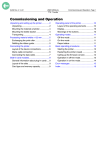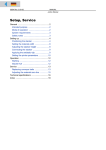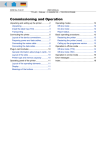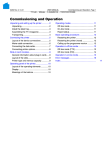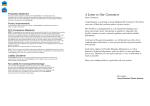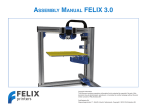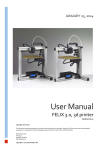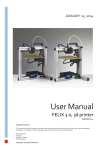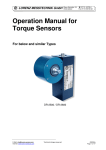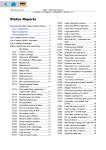Download Servicing the Print Module
Transcript
06/04 Rev. 3.00-02 SERVICE MANUAL TTK Servicing the Print Module Construction of the print module .................... 2 Dismantling the print module ......................... 3 Draw unit........................................................ 5 How to completely dismantle the draw unit ............................................................. 5 Dismantling the feed roller.......................... 6 Dismantling the pressure roller................... 7 Print unit......................................................... 8 Head-raising mechanism............................ 8 Dismantling the print unit.......................... 10 Print head contact adjustment.................. 11 Print head..................................................... 12 General information about the print head. 12 Setting the head voltage........................... 12 Setting further head parameters............... 12 Dismantling the print head........................ 13 Print head adjustment...................................14 Correcting the position in print direction....14 Correcting displacement ...........................15 Head aperture adjustment ........................15 Brake unit .....................................................19 Brake roller................................................19 Dismantling the brake unit ........................20 Contact axle ..............................................21 Gap photoelectric switch...........................22 Material end photoelectric switch..............23 Ribbon transport unit ....................................24 Ribbon unwinder .......................................24 Ribbon take-up..........................................25 Ribbon roller..............................................27 Adjusting the ribbon tautness....................28 Index.............................................................29 2 06/04 Rev. 3.00-02 SERVICE MANUAL TTK Construction of the print module The print module (ill.: dispenser version) comprises the cast plate (1) with the components mounted on top: - Servicing the Print Module 1 2 4 3 Ribbon roll-up mandrel (2) Ribbon unwind mandrel (3) Ribbon transport roller (4) Draw unit (5) Print unit (6) Brake unit (7) Head-raising mechanism (8) Other components 5 8 7 9 ¯ The print module can be completely removed from the printer! 4 2 3 6 5 7 3 06/04 Rev. 3.00-02 SERVICE MANUAL TTK Servicing the Print Module Dismantling the print module 1 It is relatively simple to remove the cast plate together with the components mounted on it. Proceed as described below: 2 Tools - Allan keys 2 mm, 2.5 mm and 3 mm Disassembly/assembly 1. Remove the front and rear hoods. 2. Remove the front left and bottom right housing. P Instructions for removing the housing parts can be found in the section "Housing" in the chapter "Service / General Information". 3. Pull the ribbon disc (1) off the ribbon rollup mandrel. Unscrew the Allan key screw (2) first. 4. Detach all the cables which are connected to the print module. 5. Remove the fastening screw (3) of the draw unit support. 3 6. Remove the five fastening screws (4) of the cast plate. P Continued on the next page. 4 4 4 4 4 4 06/04 Rev. 3.00-02 SERVICE MANUAL TTK 7. Carefully pull off the print module towards the motor side. Servicing the Print Module 1 ¯ When assembling the print module, note the position of the bouncer spring (2) and the switch contact (3). The switch contact must rest on the innermost cam (4) of the eccentric axis. P Information about the connections on the boards can be found in the chapter "Service - Boards". 2 4 3 5 06/04 Rev. 3.00-02 SERVICE MANUAL TTK Servicing the Print Module Draw unit The TTK/TEXXTILE holds the material taut between the tension unit and the brake unit to allow it to process very flexible textile material. Essentially, the tension unit comprises of two rollers which press down on each other, the lower of which - the transport roller - is driven. An eccentric axle provides the necessary force on the pressure roller. The following describes how to dismantle the roller and the entire draw unit. 1 Tools ----- Screwdriver Socket wrenches, sizes 6 and 8 Grip ring pliers Phillips screwdriver 2 3 How to completely dismantle the draw unit 1. Disassemble the front and rear hoods, and the front left and bottom right housings. P Instructions for removing the housing parts can be found in the section "Housing" in the chapter "Service / General Information". 2. Remove the feed motor (1) and toothed belt by unscrewing the three lock nuts on the motor flange. 3. Remove the clamping ring (2). Pull off the ratchet wheel (3) (e.g. by levering it off with a strong screwdriver). 4 4. Unscrew the support leg of the draw unit (4). 5 5. Remove the four fastening screws (5) of the draw unit. P Continued on the next page. 5 5 5 6 06/04 Rev. 3.00-02 SERVICE MANUAL TTK 6. Carefully pull the draw unit (1) out of the cast plate. Servicing the Print Module 1 Dismantling the feed roller 1. Proceed as if removing the entire draw unit until Step 3 (removing the ratchet wheel). 2. Remove the locking screw (2). 3. Pull out the feed roller with the bearings (3). P Continued on the next page. 2 3 7 06/04 Rev. 3.00-02 SERVICE MANUAL TTK Dismantling the pressure roller Servicing the Print Module 2 1. Dismantling the draw unit. P See the section "Completely dismantling the draw unit" for further details. 1 2. Remove the clamp/grip rings at both ends of the eccentric axle (1). 3. Thread the eccentric axle out of its bearing (2). 4. Clap up the support balancer (3) of the pressure roller. Remove the lock screw (4). 5. Thread the pressure roller with the bearings out of the balancer (5). 3 4 5 8 06/04 Rev. 3.00-02 SERVICE MANUAL TTK Servicing the Print Module Print unit Essentially the print unit (1) comprises of the: – – – – print head (2), contact roller (3), ribbon guide (4), head-raising mechanism. 1 2 4 The following describes how to dismantle the entire print unit. Head-raising mechanism 3 If the ribbon economy function is activated, the ribbon transport unit is halted over longer print-free ranges, and at the same time the print head is raised from the material. This task is carried by the head-raising mechanism (5), which is driven by a separate motor. Tools – Allan keys, 2.5 and 5 mm – Screwdriver 5 Disassembly/assembly 1. Remove the front and rear hoods and the front left housing. P Instructions for removing the housing parts can be found in the section "Housing" in the chapter "Service / General Information". 2. Remove the board base in order to access the head-raising mechanism. P See the section "Board base", chapter "Service / General Information" for further information 3. Unhitch the spring (6) from the lever (7). P Continued on the next page. 6 7 9 06/04 Rev. 3.00-02 SERVICE MANUAL TTK Servicing the Print Module 4. Unscrew the grub screw (1). 5. Detach the head-raising mechanism (2 and 3). P Continued on the next page. 4 2 3 10 06/04 Rev. 3.00-02 SERVICE MANUAL TTK Servicing the Print Module Dismantling the print unit The rest of the print unit can be removed once the head-raising mechanism has been dismantled. 1 Tool – Allan key, 5 mm Disassembly/assembly 1. Dismantle the head-raising mechanism as described in the previous section. 2. Remove the two fastening screws (1) – one on each side of the partition. 3. Detach the print unit. 1 11 06/04 Rev. 3.00-02 SERVICE MANUAL TTK Servicing the Print Module Print head contact adjustment The initial tension in the tension spring (1) and the position of the adjustment knob (2) determine the extent of the print head contact (if it is not in the ribbon economy position). 2 3 Tools – Spring balance 0 to 50 N (part no. 93665) – Fork spanner SW 7 – Coupling (part no. 96140) Adjustment 4 1. Remove the rear hood. P Instructions for removing the housing parts can be found in the section "Housing" in the chapter "Service / General Information". 5 6 2. Set the adjustment knob (1) to the minimum contact pressure (3). 3. Turn the sliding block on the head motor until the contact arm of the head-raising mechanism is recessed into the groove of the sliding block ( = print head is in the depressed position). 4. Screw the coupling onto the bolts (4). 5. Unscrew the fastening nut (5). 6. Attach the spring balance to the coupling and pull on it until the spring balance shows 9 N. 7. At the same time, tighten the fastening nuts against the axis (6) and lock them. 1 12 06/04 Rev. 3.00-02 SERVICE MANUAL TTK Servicing the Print Module Print head ¯ The print head (thermo head) is very sensitive, in particular to static electricity. Static charges may not be allowed to make contact with the thermo head when handling the component. This applies in particular when it has been disassembled. General information about the print head Print head A flat head type thermo head is used. The thermo head is connected to the CPU mainboard by two connector cables. There are electronic and mechanical setting options. Settings Electronic settings: – Supply voltage to the print head (HV99) – Resistance value of the implemented print head (HRES) Mechanical settings: – Position of the print head – Adjustment of the print head contact pressure – Setting of the print head contact pressure (operator setting) – Power supply (temperature) of the print head – Adjustment of the head aperture Setting the head voltage ¯ A falsely set maximum supply voltage can destroy the thermal bar! 1. In on-line mode press the buttons FEED+CUT(NEXT). Display: HVxx (xx = value between 00 and 99) 2. Set the value xx to 99 by pressing the feed button. 3. Use the potentiometer R25 on the stepper board to set the head voltage. Measure the head voltage at test point CN29. P For details about the value of the head voltage as well as for the position of the setting elements on the board, see subject section "Service - Boards". Setting further head parameters P For details about adjusting the print head temperature while printing, see chapter "Info Printouts and Parameters", parameter HVxx. P For details about setting the temperature reduction with increasing print head temperature, see chapter "Info Printouts and Parameters", parameter HEAT. P For details about setting the head resistance when changing the thermo head, see chapter "Info Printouts and Parameters", parameter HRES. 13 06/04 Rev. 3.00-02 SERVICE MANUAL TTK Servicing the Print Module Dismantling the print head ¯ When removing or replacing the print head (1), ensure there is potential equalisation between the operator's hand, the print head and the device. ¯ Please note that damage cannot be detected immediately, but that in some cases it only occurs after a lengthy runtime! ¯ The following jobs may only be carried out when the device is not connected to the power supply. Switch off the device and pull out the mains plug ! Tool – Allan key, 2.5 mm Disassembly/assembly 4 1. Remove the front hood. 4 P Instructions for removing the housing parts can be found in the section "Housing" in the chapter "Service / General Information". 1 2. The print head can be accessed more easily if you remove the print roller (2) first. Ô To do this, unscrew the thumb screw () and pull the print roller (3) out of its mounting. 5 P Additional information about removing the print roller can be found in the section "Replacing the print roller" in the chapter "Commissioning and Operation". 3. Detach both connector cables from the print head. 1 2 3 4. Unscrew the two print head fastening screws (4). 5. Remove the print head from the print head mounting (5) in a downward motion (if you have already removed the print roller) or towards the rear of the printer. ¯ During assembly, press the print head firmly on both sides onto the setting screws (6) in the head mounting, and at the same time tighten the fastening screws (4). 4 6 14 06/04 Rev. 3.00-02 SERVICE MANUAL TTK Servicing the Print Module Print head adjustment When changing the thermo head it may be necessary to make the following adjustments: ¯ If necessary, programme the head resistance by adapting the parameter HRES accordingly. (Make a note of the head resistance given on the print head before assembly!) ¯ Check the print quality and the direction of the printout. • Insufficient print density: for measures, see the section "Position in print direction". • Crooked printout: for measures, see the section "Correcting displacement". Correcting the position in print direction 1. Set the print head supply voltage to HV99. To do this, press the CUT+FEED button in the on-line mode. Increase the setting value to 99 by pressing the FEED button. Exit the parameter menu by pressing the CUT+FEED button. 2. In the parameter menu select INFO/DOT1 and confirm by pressing the ENTER button. The printer prints a dot test pattern. 3. Check the print density. If the printout is not of a solid black colour, the print head is not making contact on the highest point of the contact roller. In this case, screw in both of the grub screws (1) on the front of the head mounting by approx. one turn. Repeat steps 5 and 6 until the printout is a solid black colour. ¯ The print density is decreased if the grub screws have been tightened too much. Loosen both screws to correct this. 1 1 15 06/04 Rev. 3.00-02 SERVICE MANUAL TTK Servicing the Print Module Correcting displacement Check whether the edges of the printout are parallel to the borders of the labels. This is easier to check if the borders are as narrow as possible. Proceed as follows: 1. Set the parameter PRTP/YPOS to 1 or 2 (test). This shifts the printout relative to the edge of the label. 2. Start INFO/STA2. 3. Correct any displacement (1) using the grub screws in the head mounting. Example (ill.): tightening the screw (3), unscrewing the screw (2). 1 2 3 Head aperture adjustment The head aperture is adjusted on the headraising mechanism (4). The sliding block and oscillator disc of the head motor (5) are not easily visible; dismantled parts are therefore used in the illustrations to demonstrate the settings. Nominal value When switched on and with ribbon inserted, the aperture between the thermo head and feed axle should measure between 0.75 mm and 1.00 mm. If this is not the case, set the head aperture as follows: Setting: 1. Remove any material. 2. Insert some ribbon if you have not done so already. 3. Printer reset: Press the FEED+CUT(NEXT)+ON/OFF buttons. Display: (flashing) INIT While INIT is flashing, press the ON/OFF button. Display: CODE P Continued on the next page. 5 4 16 06/04 Rev. 3.00-02 SERVICE MANUAL TTK Servicing the Print Module 4. Press the following buttons one after the other: FEED CUT ON/OFF ON/OFF FEED CUT 5. If ON is displayed, press the ON/OFF button. Display: OFF 6. Press the FEED+CUT button. Display: INFO 7. Press the CUT button several times until: Display: OTHR 8. Press the ON/OFF button. Display: DOWN 9. Press the CUT button several times until: Display: 1 HADJ 10. Press the ON/OFF button. Display: YES 2 11. Press the ENTER button: Display: H 12. Press the ENTER button again. Display: H printer emits a tone. 13. Switch off the printer using the mains switch ! 14. Unscrew the screw (1) on the head lever. 15. Unscrew the grub screw (2) on the oscillator disc. 16. Turn the sliding block (3) into the print position. The contact arm (4) must now be in the groove of the sliding block (5). 3 5 6 4 17 06/04 Rev. 3.00-02 P Continued on the next page. SERVICE MANUAL TTK Servicing the Print Module 18 06/04 Rev. 3.00-02 SERVICE MANUAL TTK Servicing the Print Module 17. Lay 0.1 mm thick material (6) between the sliding block and the contact arm. 18. Press the contact arm (1) against the sliding block and retighten the screw. 1 19. Switch on the printer. The printer should still be in the HADJ mode (Hx). 20. Ensure that the notch of the oscillator disc (1) is at its highest point (12 o'clock). Turn the notch slowly in a clockwise direction (viewpoint: standing in front of the opened rear hood), until 0 (zero) is shown on the display. This should occur when the edge of the notch passes the photoelectric switch (2). Carefully retighten the grub screw of the oscillator disc. (Do not overtighten because otherwise the plastic thread will be damaged.) 21. Press the ENTER button: The printer has now been reset! The head aperture should now be set correctly. 2 19 06/04 Rev. 3.00-02 SERVICE MANUAL TTK Brake unit Servicing the Print Module 5 – – – – 4 2 The following major components of the brake unit (1) are described in the following: 3 Brake roller (2) Contact axle (3) Material end photoelectric switch (4) Gap photoelectric switch (5) Brake roller 1 Tools – Phillips screwdriver medium size Disassembly / Assembly 1. Unscrew the locking screw (6). Turn the plate (7) aside. 2. Pull out the brake roller (2). 3. Insert the new brake roller. 7 4. Fix the plate, so that the brake roller cannot move in an axial direction. 6 2 20 06/04 Rev. 3.00-02 SERVICE MANUAL TTK Dismantling the brake unit Servicing the Print Module 2 1. Proceed as described in the section "Dismantling the brake roller". 2. Remove the grip ring (1) and the red lever (2) by unhitching the tension spring at the top of the lever. 1 3 3. Remove the two hexagonal screws (3). 4. Carefully pull out the brake unit (4). Thread through the connector cable of the photoelectric switches. 3 4 21 06/04 Rev. 3.00-02 SERVICE MANUAL TTK Servicing the Print Module Contact axle The contact pressure rollers (2) of the contact axle (1) provide the necessary friction between the brake roller and the material. Remove the brake unit for service work and to access the contact axle. 2 1 2 Tool 3 – Clamp ring pliers Disassembly/assembly 1. Remove the front and rear hoods. P Instructions for removing the housing parts can be found in the section "Housing" in the chapter "Service / General Information". 2. Dismantle the brake unit. P See the section "Dismantling the brake unit" for instructions. 3. Remove the grip ring (3). 4. Thread the contact axle out of the side guidings (4). 4 22 06/04 Rev. 3.00-02 SERVICE MANUAL TTK Servicing the Print Module Gap photoelectric switch The part shown here (ill. 1) is called a gap photoelectric switch. The gap photoelectric switch is fitted with a transparent sensor as standard, but a reflecting sensor can also be equipped as an option. The gap photoelectric switch is removed from the brake unit after this has been dismantled. 1 Tools – Allan key 3mm – Side-cutting pliers Disassembly/assembly 1. Remove the front and rear hoods. P Instructions for removing the housing parts can be found in the section "Housing" in the chapter "Service / General Information". 2. Dismantle the brake unit. P See the section "Dismantling the brake unit" for instructions. 2 3. Unplug the connector cable of the gap photoelectric switch from the stepper board and thread it through the aperture in the cast plate. Remove any cable binders which may be present. 4. Remove the retaining screws (2) on the two guide axles. 2 3 5. Pull out the guide axles (3). 6. Remove the screw (4) on the retaining plate. 3 The gap photoelectric switch can now be removed. 4 23 06/04 Rev. 3.00-02 SERVICE MANUAL TTK Servicing the Print Module Material end photoelectric switch 1 The material end photoelectric switch is integrated in the rear material guide (1). The following description and the adjacent illustrations refer to a dismantled brake unit – the parts concerned are more visible here. The material guide can, however – albeit more difficultly – be removed without dismantling the brake unit. Tools – Allan key size 2.5 – Grip ring pliers 2 Disassembly/assembly 3 1. Remove the front and rear hoods. P Instructions for removing the housing parts can be found in the section "Housing" in the chapter "Service / General Information". 2. Dismantle the brake unit. P See the section "Dismantling the brake unit" for instructions. 5 5 3. Unscrew the thumb screw of the front material guide (2). 4 4. Unscrew the grub screw (3) on the bottom of the rear material guide. 5. Push the grip ring (4) to the middle of the axle. 5 6. Push the axle to one side against the resistance of the clamping ring (5). 7. Pull the clamping ring and material guide off the side which is now clear (6). 3. Unplug the connector cable of the gap photoelectric switch from the stepper board and thread it through the aperture in the cast plate. Remove any cable binders which may be present. 6 24 06/04 Rev. 3.00-02 SERVICE MANUAL TTK Servicing the Print Module Ribbon transport unit 3 4 The following parts ensure that the ribbon is transported evenly and without folds: – – – – 1 Ribbon unwinder (1) Ribbon guide (2) Ribbon roller (3) Ribbon take-up (4) The ribbon unwinder (1) and ribbon take-up (4) are almost identical - the only difference concerns a few parts on the motor side of the print module. The unwinder is fitted with an oscillator disc (for controlling the unwinding process) and a brake disc. The take-up does not have an oscillator disc, and the brake disc is replaced by a pulley for the drive belt. Tools 2 4 1 – Socket wrenches, sizes 7 and 8 – Allan key 2 mm Ribbon unwinder Disassembly/assembly 1. Remove the rear hood. P Instructions for removing the housing parts can be found in the section "Housing" in the chapter "Service / General Information". 2. Unscrew the nut (3). Counterhold the threaded rod against the red hexagon head. 4. Turn out the threaded rod on the red hexagon head while holding on to the cap (4). P Continued on the next page. 4 3 25 06/04 Rev. 3.00-02 SERVICE MANUAL TTK Servicing the Print Module 4. Remove the cap, spacing ring, spring, shims (1), oscillator disc (2), brake disc (3), brake spring (4) and friction wheel (5). 6. Unscrew the two grub screws of the buffer disc (6). Remove the buffer disc. 6. Press/pull the unwinding mandrel towards the print head side out of the mounting. 4 5 3 1 2 ¯ Turn the cap when putting it on until it can be easily moved along the ribbon mandrel axle. 6 ¯ Pay attention to the shims on the ribbon mandrel axle (print head side). ¯ During assembly ensure that you screw the threaded rod into the cap until the contact spring is compressed by a few millimetres. Ribbon take-up Disassembly/assembly 1. Remove the rear hood. P Instructions for removing the housing parts can be found in the section "Housing" in the chapter "Service / General Information". 2. Detach the ribbon motor by removing the three fastening nuts on the motor flange. 3. Unscrew the nut (7). Counterhold the threaded rod against the red hexagon head. 4. Turn out the threaded rod on the red hexagon head while holding on to the cap (8). P Continued on the next page. 7 8 26 06/04 Rev. 3.00-02 SERVICE MANUAL TTK Servicing the Print Module 5. Remove the cap (1), spacing ring (2), spring (3), brake disc (4) and pulley (5). 6. Unscrew the two grub screws of the buffer disc (6). Remove the buffer disc. 7. Press/pull the unwinding mandrel towards the print head side out of the mounting. ¯ Turn the cap when putting it on until it can be easily moved along the ribbon mandrel axle. ¯ 3 2 1 Pay attention to the shims on the ribbon mandrel axle (print head side). ¯ During assembly ensure that you screw 6 the threaded rod into the cap until the contact spring is compressed by a few millimetres. 6 4 5 27 06/04 Rev. 3.00-02 SERVICE MANUAL TTK Servicing the Print Module Ribbon roller 2 The ribbon roller is driven together with the ribbon rewinder by the ribbon motor (1). The motor must be removed first. Tools 2 1 -- Phillips screwdriver -- Screwdriver 2 Disassembly/assembly 1. Remove the front hood and front left housing. P Instructions for removing the housing parts can be found in the section "Housing" in the chapter "Service / General Information". 4 3 2. Remove the ribbon motor by unscrewing the three fastening nuts (2). 3. Remove the clamping ring (3). 4. Pull off the ratchet wheel (4). 5. Press/pull the ribbon roller (5) towards the print head side out of the mounting. 6. Pull the ribbon dancer rod (6) off the ribbon roller. 5 6 28 06/04 Rev. 3.00-02 SERVICE MANUAL TTK Servicing the Print Module Adjusting the ribbon tautness The braking torque of the ribbon unwind mandrel and the ribbon roll up mandrel can be set from the front using the red plastic hexagonal nuts (1) on the ribbon mandrels. The braking torque is increased by turning them in a clockwise direction. 1 1 P Also read chapter “Setting the ribbon tautness”, subject section “Setup” of the user manual. The tractive force on the ribbon is proportional to the roll unwinding/roll-up torque. One can measure this with a spring balance. Tool - Fish balance 5 N (2) (ID-Nr. 93665-01) Adjusting Adjust the braking torque as follows: 1. Place an empty ribbon sleeve (3) onto the mandrel. 2 2. Wrap some windings of ribbon onto the sleeve. Fix the beginning of the ribbon on the sleeve! 3. Twist the ribbon end and tie a sling in to it. 4. Hang the spring balance (2) to the sling and pull on it until the mandrel slips through and turns. Readout the pulling force. 2 5. Increase/decrease the braking torque by turning the red hexagonal nut. 6. Repeat steps 4 and 5, until the demanded value is adjusted. • Tractive force roll-up mandrel (4): 1.8 bis 2.1 N • Tractive force unwind mandrel (5): 1.6 bis 1.8 N 3 1 29 06/04 Rev. 3.00-02 SERVICE MANUAL TTK Servicing the Print Module Index Pressure roller, draw unit............................ 7 Print head ................................................. 12 Print head contact, adjustment ................. 11 Print head, correcting position in print direction .................................................... 14 Print head, dismantling ............................. 13 Print image displacement ......................... 15 Print module, construction .......................... 2 Print unit...................................................... 8 Print unit, dismantling ............................... 10 B Brake roller, dismantling............................ 18 Brake unit .................................................. 18 Brake unit, dismantling.............................. 19 C Construction of the print module ................. 2 Contact axle .............................................. 20 D Disassembly, print module .......................... 3 Draw unit ..................................................... 5 F R Ribbon Automatic economy ................................. 8 tautness, adjusting the ........................... 28 Ribbon roller ............................................. 26 Ribbon take-up ......................................... 24 Ribbon transport unit ................................ 23 Ribbon unwinder....................................... 23 Ribbon zero line........................................ 27 Feed motor.................................................. 5 Feed roller ................................................... 6 H Head aperture adjustment......................... 15 Head resistance, setting............................ 12 Head voltage, setting ................................ 12 Head-raising mechanism ............................ 8 M Material guide............................................ 22 P Photoelectric switch, Gap.......................... 21 Photoelectric switch, material end- ........... 22 T Toothbelt..................................................... 5 Z Zero line, ribbon........................................ 27





























